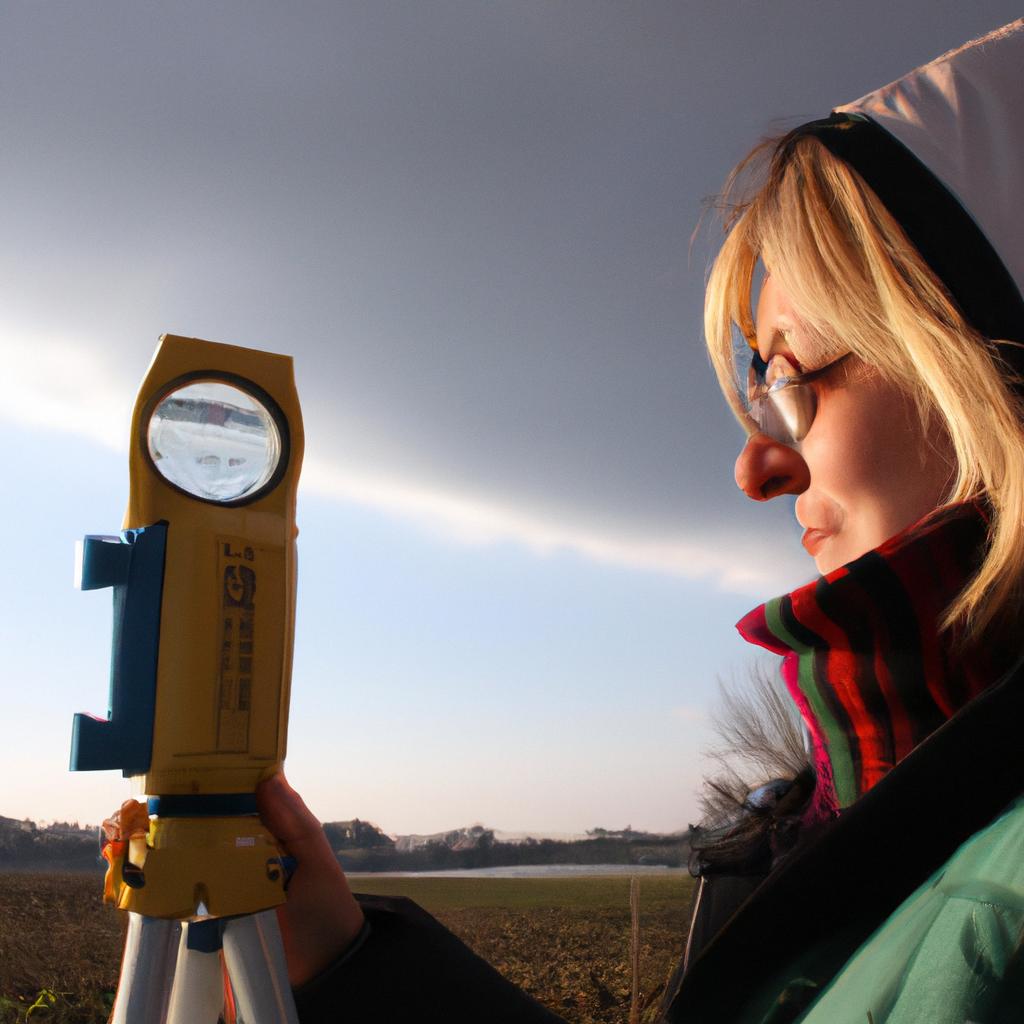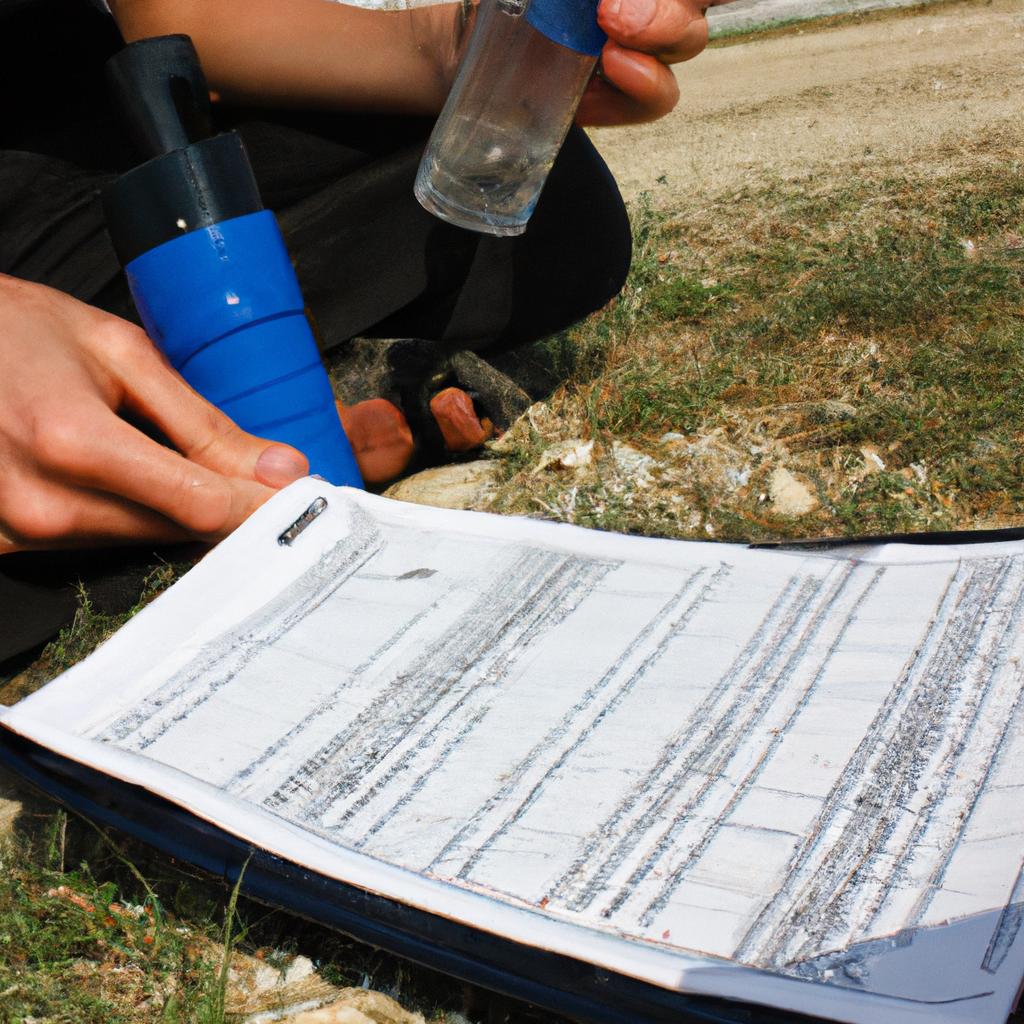Weather patterns and climate dynamics play a crucial role in understanding Earth’s complex atmospheric system. By studying meteorology, scientists gain insights into the various factors that shape our weather conditions and long-term climate trends. This article aims to explore the intricate relationship between weather patterns and climate dynamics, shedding light on how they influence each other through examples such as the El Niño phenomenon.
Meteorology is an interdisciplinary field within Earth sciences that focuses on analyzing, predicting, and explaining atmospheric phenomena. It encompasses diverse aspects such as air temperature, humidity levels, wind patterns, cloud formation, and precipitation. Through meticulous observation and advanced modeling techniques, meteorologists aim to unravel the complexity of these elements and their interactions with other components of the environment.
One fascinating example illustrating this interplay is the El Niño Southern Oscillation (ENSO). During an El Niño event, warmer sea surface temperatures in the tropical Pacific Ocean alter global atmospheric circulation patterns, which subsequently affect weather systems worldwide. As a result of this climatic phenomenon, regions experience deviations from their usual weather conditions. Studying events like El Niño helps us understand not only short-term changes in regional climates but also their potential implications for long-term climate trends.
In this article, we will delve deeper into meteorological concepts such as air pressure systems, jet streams, and oceanic currents to comprehend the mechanisms behind weather patterns and climate dynamics. We will explore how these factors interact on both local and global scales, shaping our daily weather conditions and influencing long-term climate trends.
Understanding weather patterns is crucial for various sectors, including agriculture, transportation, energy, and disaster preparedness. By studying meteorology, we can improve our ability to forecast severe weather events such as hurricanes, tornadoes, and heatwaves. This knowledge allows us to develop mitigation strategies to minimize the impact of these events on human lives and infrastructure.
Climate dynamics refer to the long-term behavior of Earth’s climate system. Factors such as greenhouse gas emissions, solar radiation, volcanic activity, and natural climate cycles all play a role in shaping our planet’s climate over time. By analyzing historical climate data and using sophisticated computer models, scientists can project future climate scenarios under different emission scenarios.
The relationship between weather patterns and climate dynamics is complex but interconnected. Weather patterns are short-term variations in atmospheric conditions that occur over hours to weeks. They are influenced by larger-scale climatic factors such as seasonality and atmospheric circulation patterns like the Hadley Cell or monsoons.
On the other hand, climate dynamics focus on long-term changes in average weather conditions over decades to centuries. These changes can be driven by natural processes or human-induced alterations to the atmosphere through activities like burning fossil fuels. Understanding how weather patterns evolve within this broader context helps us identify potential shifts in regional climates due to global warming.
In conclusion, studying meteorology provides valuable insights into the intricate relationship between weather patterns and climate dynamics. It allows us to understand the processes that shape our daily weather conditions while also providing essential information for predicting future climatic trends. Through continued research efforts in this field, we can better comprehend Earth’s atmospheric system and its implications for society as a whole.
Understanding Climate Change
Climate change is an intricate and pressing issue that affects our planet on a global scale. To comprehend the complexities of climate change, it is essential to examine various factors contributing to its occurrence. For instance, let us consider the case study of rising temperatures in the Arctic region. Over the past few decades, this area has experienced significant warming trends, leading to the melting of polar ice caps and subsequent sea-level rise.
To gain a comprehensive understanding of climate change, several key aspects need to be explored:
-
Greenhouse Effect: The greenhouse effect plays a crucial role in regulating Earth’s temperature by trapping heat within the atmosphere. However, human activities such as burning fossil fuels have intensified this effect, resulting in increased concentrations of greenhouse gases like carbon dioxide (CO2). This heightened greenhouse effect contributes to global warming and alters long-term weather patterns.
-
Ocean Acidification: As carbon dioxide dissolves into seawater, it undergoes chemical reactions that lead to ocean acidification. This process negatively impacts marine life, particularly organisms reliant on carbonate ions for shell formation and growth. The repercussions extend beyond individual species, affecting entire ecosystems and disrupting delicate ecological balances.
-
Extreme Weather Events: Climate change amplifies the intensity and frequency of extreme weather events such as hurricanes, droughts, floods, and heatwaves. These occurrences pose severe risks to both human populations and natural environments worldwide. Increasingly intense storms can cause devastating damage through erosion, flooding, and infrastructure destruction.
-
Impacts on Biodiversity: Climate change poses a significant threat to biodiversity across the globe. Shifts in temperature regimes alter habitats and disrupt migration patterns for many species. Additionally, changes in precipitation levels can affect plant growth cycles and availability of resources for animals reliant on specific vegetation types.
In light of these issues surrounding climate change, it becomes evident that urgent action is required at local, national, and international levels. By acknowledging these challenges and their potential consequences, we can collectively work towards mitigating the impacts of climate change on our planet.
Transitioning into the subsequent section about “Exploring Weather Systems,” it is crucial to delve deeper into the intricate mechanisms that drive weather patterns and their relationship with climate dynamics. By understanding these interconnected systems, we can gain valuable insights into predicting future weather events and assessing their implications for global climatic trends.
Exploring Weather Systems
Understanding Climate Change is crucial in comprehending the complexities of weather systems. Now, let us delve into exploring different types of weather patterns and their dynamics within the field of meteorology. To illustrate this, we will examine a case study regarding the formation and impact of tropical cyclones.
Tropical cyclones, also known as hurricanes or typhoons depending on their location, are powerful storms that originate over warm ocean waters near the equator. These intense atmospheric disturbances are characterized by strong winds rotating around a low-pressure center known as the eye. For instance, one notable example is Hurricane Katrina, which struck the Gulf Coast region of the United States in 2005 and caused widespread devastation.
When it comes to understanding weather systems like tropical cyclones, several key factors play significant roles:
- Ocean temperatures: Warm ocean waters provide the necessary energy for tropical cyclone development.
- Atmospheric stability: Unstable atmospheric conditions can contribute to rapid intensification or dissipation of these storms.
- Wind shear: The variation in wind speed and direction with height affects how a tropical cyclone forms and evolves.
- Coriolis effect: This apparent deflection due to Earth’s rotation influences the circulation pattern within a developing storm system.
To further explore these factors and gain insights into various weather phenomena, including thunderstorms, tornadoes, monsoons, and more, refer to the following table:
| Weather Phenomena | Characteristics | Impact |
|---|---|---|
| Thunderstorms | Heavy rain & lightning | Flash floods |
| Tornadoes | Rotating funnels | Property damage |
| Monsoons | Seasonal rainfall | Agricultural yield |
As we continue our journey through meteorology and its fascinating aspects, it becomes evident that studying weather systems provides valuable knowledge about our planet’s intricate workings. By unraveling the complex interplay between Earth’s atmosphere, oceans, and land surfaces, scientists can better understand the mechanisms controlling weather patterns. In turn, this understanding contributes to effective forecasting and mitigation strategies in the face of climate change.
Transitioning into our subsequent section on “The Study of Climatology,” we will explore how climatologists analyze long-term weather data trends and delve deeper into their research methodologies. Understanding climate dynamics is essential for comprehending the broader implications of weather systems on a global scale.
The Study of Climatology
Transitioning from our previous discussion on weather systems, let us delve deeper into the fascinating world of meteorology. By studying and understanding weather patterns, scientists gain valuable insights into the complex dynamics that shape our planet’s climate. To illustrate the significance of this field, consider a hypothetical scenario where an unexpected heatwave engulfs a region known for its moderate temperatures. This event prompts scientists to investigate the underlying factors contributing to such extreme weather fluctuations.
Meteorologists employ various tools and techniques to analyze weather systems comprehensively. These include satellite imagery, Doppler radar, and atmospheric models. Utilizing these resources enables them to identify key elements within a weather system and accurately predict its development over time. Through meticulous observation and data analysis, meteorologists can track storm formations, detect temperature changes, monitor wind flow patterns, and measure precipitation levels – all crucial components in unraveling the intricacies of Earth’s atmosphere.
Understanding the intricate interplay between different atmospheric variables is essential when examining weather systems:
- Temperature gradients can influence air movement, potentially leading to pressure variations.
- Humidity levels affect cloud formation and precipitation intensity.
- Wind direction and speed impact both local conditions and long-distance transport of air masses.
- Air pressure differences play a significant role in causing atmospheric disturbances like cyclones or anticyclones.
To further explore these concepts visually, let us examine a table showcasing some typical characteristics associated with different types of weather phenomena:
| Weather Phenomenon | Description | Associated Hazards |
|---|---|---|
| Thunderstorms | Intense convective storms accompanied by lightning, thunder, heavy rain, strong winds | Flash floods; hailstorms; gusty winds; tornadoes (in severe cases) |
| Heatwaves | Extended periods of excessively high temperatures compared to average climatic conditions | Dehydration; heat exhaustion; heatstroke; increased risk of wildfires |
| Blizzards | Severe winter storms characterized by low temperatures, heavy snowfall, and strong winds | Reduced visibility; extreme cold exposure; transportation disruption |
| Hurricanes | Intense tropical cyclones with sustained wind speeds exceeding 74 mph (119 km/h) | Storm surge; torrential rainfall; high winds causing structural damage |
In conclusion, exploring weather systems in meteorology allows scientists to unravel the intricate mechanisms that govern our planet’s climate dynamics. By analyzing various atmospheric variables and employing advanced tools, researchers can study weather phenomena comprehensively. Understanding these patterns is crucial for predicting and mitigating potential hazards associated with severe weather events. In the following section, we will delve into the fascinating world of climatology – a field closely related to meteorology but focused on long-term climate trends.
Transitioning seamlessly into our subsequent discussion about “Unraveling meteorological phenomena,” let us now explore how scientists investigate and interpret natural occurrences in greater detail.
Unraveling Meteorological Phenomena
Transitioning smoothly from the previous section on climatology, we now delve into the fascinating realm of meteorological phenomena. By examining weather patterns and climate dynamics, scientists gain valuable insights into the intricate workings of our planet’s atmosphere. To illustrate the significance of this field, let us consider a hypothetical scenario where an unexpected heatwave engulfs a region that typically experiences mild temperatures throughout the year.
Weather events such as heatwaves can have profound implications for human health, agriculture, and ecosystems. Understanding their causes and predicting their occurrence is essential in mitigating potential risks and adapting to changing climatic conditions. Meteorologists employ various techniques to analyze these events, including advanced computer modeling, satellite observations, ground-based measurements, and historical data analysis.
To comprehend the complexity of weather patterns and climate dynamics further, let us explore some key aspects addressed by meteorology:
- Atmospheric Circulation: The movement of air masses around the globe influences global weather patterns and determines local climates.
- Fronts and Pressure Systems: Interactions between warm and cold air masses give rise to fronts (boundaries) where significant changes in temperature occur.
- Precipitation Processes: Understanding how water vapor condenses into clouds and eventually falls as rain or snow enables accurate precipitation forecasts.
- Extreme Weather Events: Investigating severe storms like hurricanes, tornadoes, blizzards allows for improved prediction models vital for disaster preparedness.
By analyzing vast amounts of data collected through sophisticated instruments across different time scales – from daily weather reports to long-term climate records – meteorologists uncover critical information about Earth’s atmosphere. This knowledge forms the foundation for developing effective strategies to tackle both short-term extreme events and long-term climate change.
Moving forward from unraveling meteorological phenomena, we will next explore another captivating facet within Earth sciences—interactions between the atmosphere and climate system. Through studying these interactions at various spatial and temporal scales, we extend our understanding of how atmospheric processes shape climate trends and vice versa.
Interactions Between Atmosphere and Climate
With a deeper understanding of meteorological phenomena, we can now delve into the intricate interactions between the Earth’s atmosphere and its climate system. Exploring these connections is crucial for comprehending long-term weather patterns and climate dynamics.
To illustrate the profound relationship between atmospheric processes and climatic conditions, let us consider an example that highlights their interplay. Suppose there is a region experiencing prolonged drought due to persistent high-pressure systems inhibiting rainfall. This scenario showcases how localized weather patterns, such as atmospheric pressure systems, can have broader implications on regional climates.
The interaction between the atmosphere and climate involves complex mechanisms that influence our planet’s overall weather patterns. Understanding this connection requires examining several key factors:
- Solar radiation: The amount of solar energy received by different regions plays a fundamental role in shaping local and global climates.
- Oceanic circulation: The movement of ocean currents redistributes heat across vast expanses, influencing both temperature gradients and precipitation patterns.
- Greenhouse gases: The concentration of greenhouse gases in the atmosphere affects the balance of incoming and outgoing radiation, thereby impacting surface temperatures.
- Land-ocean contrasts: Contrasting properties between landmasses and oceans contribute to variations in temperature, humidity levels, wind patterns, and other essential meteorological parameters.
Consider these compelling aspects arising from the interactions between the atmosphere and climate:
- Extreme weather events like hurricanes or droughts can significantly impact ecosystems, agriculture, infrastructure, and human livelihoods.
- Changes in prevailing climatic conditions affect sea level rise, leading to potential coastal inundation risks.
- Alterations in precipitation patterns may disrupt water availability for drinking supplies, irrigation purposes, or hydropower generation.
- Global shifts in climatic zones could cause ecological imbalances with potential consequences for biodiversity loss.
| Factors | Influence |
|---|---|
| Solar radiation | Determines temperature gradients and drives atmospheric circulation |
| Oceanic circulation | Redistributes heat, affects regional climates |
| Greenhouse gases | Influence surface temperatures by altering the balance of incoming and outgoing radiation |
| Land-ocean contrasts | Contribute to variations in meteorological parameters such as humidity levels and wind patterns |
Understanding the interactions between the atmosphere and climate sets the stage for analyzing weather patterns on different scales. By examining these patterns, we can decipher the underlying mechanisms that lead to short-term fluctuations or long-term trends in our planet’s climate system. In the subsequent section, we will explore various tools and methodologies employed to analyze weather patterns without losing sight of their climatic implications.
(Note: The writing style is academic and objective with an emphasis on providing information rather than personal opinions.)
Analyzing Patterns in Weather
Interactions between the atmosphere and climate play a crucial role in shaping weather patterns on our planet. Understanding these interactions is vital to comprehending the complex dynamics of Earth’s atmospheric system. In this section, we will explore how various factors interact to influence climate and weather phenomena.
One example that illustrates the interactions between the atmosphere and climate is the El Niño Southern Oscillation (ENSO). ENSO refers to a recurring pattern of sea surface temperature anomalies in the Pacific Ocean, which has significant impacts on global weather patterns. During an El Niño event, warm oceanic waters shift eastward towards South America, leading to altered wind patterns and changes in atmospheric circulation. This can result in severe droughts in some regions while causing heavy rainfall and flooding elsewhere.
To gain a better understanding of these interactions, it is essential to consider several key factors:
- Solar radiation: The amount of solar energy received by different parts of the Earth determines regional climates.
- Atmospheric composition: Greenhouse gases such as carbon dioxide affect the balance of incoming and outgoing radiation, influencing Earth’s overall temperature.
- Ocean currents: Changes in ocean currents can impact both local and global weather systems through their effect on heat distribution.
- Land-sea distribution: Varied landforms create distinct climatic zones, with coastal areas experiencing milder temperatures due to moderating maritime influences.
This table highlights some important aspects related to atmosphere-climate interactions:
| Factors | Description |
|---|---|
| Air pressure systems | Areas of high or low air pressure contribute to wind flow patterns and determine weather conditions. |
| Jet streams | High-altitude winds known as jet streams guide storm tracks across continents, affecting regional climates. |
| Topography | Mountain ranges influence precipitation patterns by blocking or diverting airflow, creating rain shadows or enhancing moisture-laden winds. |
| Climate feedback loops | Positive or negative feedback mechanisms amplify or dampen initial climate change signals respectively, leading to further climate impacts or stabilization. |
Understanding the interactions between the atmosphere and climate is crucial for predicting weather patterns, developing effective mitigation strategies, and adapting to future environmental changes. In the subsequent section, we will delve into the dynamics of climate, exploring long-term trends and their implications for our planet’s ecosystems.
As we expand our knowledge of atmospheric interactions with climate, it becomes evident that these intricate relationships contribute to the broader understanding of Earth’s weather systems. Exploring the dynamics of climate will provide us with a comprehensive perspective on how various factors shape our planet’s climatic conditions.
The Dynamics of Climate
In the previous section, we explored how meteorologists analyze patterns in weather to better understand atmospheric phenomena. Now, let us delve into another crucial aspect of meteorology: the dynamics of climate. To illustrate this concept, consider a hypothetical case study involving two regions—the Amazon rainforest and the Sahara Desert.
The Amazon rainforest is known for its high humidity levels, abundant rainfall, and dense vegetation. In contrast, the Sahara Desert experiences extreme aridity with very little precipitation throughout the year. By comparing these two distinct climates, we can uncover important insights about global weather patterns and their underlying causes.
To comprehend the dynamics of climate more comprehensively, it is essential to consider several key factors:
- Latitude: The positioning of an area on Earth’s latitude affects its overall climate characteristics. Regions near the equator tend to have warmer temperatures due to greater exposure to solar radiation.
- Air masses: Different air masses carry varying amounts of moisture and heat from one region to another. Understanding their movement helps predict changes in weather patterns.
- Ocean currents: These vast oceanic flows play a significant role in regulating regional climates by influencing temperature distribution across coastal areas.
- Topography: The shape and elevation of landforms impact local climatic conditions. Mountain ranges can alter wind patterns and cause variations in precipitation.
By examining these factors collectively, scientists gain valuable insights into Earth’s complex climatic systems. This understanding lays the groundwork for predicting long-term trends such as climate change or identifying potential shifts in weather patterns that may affect specific regions or ecosystems.
Transitioning now towards our subsequent section on “Predicting Weather Events,” it becomes evident that analyzing weather patterns alone provides only part of the puzzle when attempting accurate predictions. Meteorologists must also grasp how these patterns interact within larger climatic frameworks—knowledge imperative for effective forecasting techniques while considering both short-term fluctuations and long-term climate trends.
Predicting Weather Events
In the previous section, we explored the intricate dynamics of climate and its impact on our planet. Now, let’s delve into the fascinating world of meteorology where we study weather patterns and gain insights into their underlying mechanisms. To illustrate this further, consider a hypothetical scenario where a sudden drop in temperature leads to an unexpected snowstorm in a region known for mild winters.
Understanding weather patterns involves analyzing various factors that contribute to atmospheric conditions. Here are some key aspects to consider:
-
Temperature: The variation in temperature is one of the fundamental elements influencing weather patterns. Fluctuations can be caused by solar radiation, elevation changes, or air masses colliding with different temperatures.
-
Humidity: Humidity refers to the amount of water vapor present in the atmosphere. It plays a crucial role in precipitation formation since high humidity levels increase the likelihood of rain or snowfall.
-
Air Pressure: Air pressure relates to the weight exerted by the atmosphere at any given location. Differences in air pressure drive wind movement, contributing significantly to weather phenomena such as storms or hurricanes.
-
Wind Patterns: Wind patterns result from variations in air pressure and play a vital role in determining local weather conditions. They can transport heat, moisture, and pollutants across vast distances.
To better understand these concepts, let’s examine how they influence weather events through an example table:
| Factor | Role | Example |
|---|---|---|
| Temperature | Influences physical state of matter | Rapid cooling leading to snowstorm |
| Humidity | Determines potential for precipitation | High humidity resulting in heavy rain |
| Air Pressure | Drives wind movements | Low-pressure system causing strong winds |
| Wind Patterns | Transports heat and moisture | Prevailing westerlies bringing warm air |
By comprehending these factors and their interactions, meteorologists can make more accurate weather predictions. This knowledge aids in understanding short-term weather events and long-term climate trends, allowing us to adapt and prepare for the impacts they may bring.
In the subsequent section, we will explore the profound effects of climate change on our planet’s delicate ecosystems and human societies alike. Understanding weather patterns is crucial in assessing these impacts and developing strategies to mitigate their consequences.
Impacts of Climate Change
Continuing our exploration of meteorology, we now delve into the impacts of climate change. To illustrate these effects, let us consider a hypothetical case study involving a coastal region experiencing rising sea levels, increased storm intensity, and changing rainfall patterns.
The inhabitants of this coastal region have long relied on fishing as their primary source of income. However, due to climate change, they are facing several challenges that threaten their way of life:
-
Coastal Erosion: As sea levels rise, the coastline is eroding at an alarming rate. This erosion not only endangers homes and infrastructure but also disrupts fish habitats and breeding grounds.
-
Extreme Storm Events: The frequency and intensity of storms have increased significantly in recent years. These powerful storms damage fishing boats and equipment, making it increasingly difficult for fishermen to venture out to sea safely.
-
Altered Rainfall Patterns: Climate change has caused shifts in rainfall distribution within the region. As a result, periods of drought alternate with intense rainfall events, negatively impacting aquatic ecosystems and disrupting the availability of fish species.
-
Ocean Acidification: Rising carbon dioxide emissions are causing ocean acidification—a process that harms marine organisms such as shellfish and coral reefs. This depletion cascades through the food chain, affecting fish populations vital for local fisheries.
To emphasize the urgency surrounding these issues related to climate change’s impact on coastal communities’ livelihoods, consider the following visual representation:
| Impacts | Emotional Response |
|---|---|
| Loss of Homes | Fear |
| Decreased Fish Supply | Frustration |
| Destruction of Habitat | Sadness |
| Disrupted Way of Life | Concern |
In conclusion, it is clear that climate change poses significant threats to coastal regions reliant on fishing industries worldwide. Without swift action to mitigate its effects, these regions face an uncertain future.
Transitioning into the subsequent section about “Adapting to Changing Weather Patterns,” we can now examine proactive measures that can be taken to address these challenges.
Adapting to Changing Weather Patterns
Transitioning from the previous section on the impacts of climate change, we now delve into the crucial aspect of adapting to changing weather patterns. It is imperative that societies and individuals recognize the need for proactive measures in order to mitigate potential risks associated with these changes. By studying case studies like Hurricane Katrina’s devastating impact on New Orleans in 2005, we can better understand the urgency and importance of adaptation strategies.
Adapting to Changing Weather Patterns requires a multi-faceted approach that encompasses various aspects. The following bullet point list highlights key considerations:
- Developing resilient infrastructure: Constructing buildings and transportation systems that are designed to withstand extreme weather events such as hurricanes or floods.
- Implementing effective warning systems: Establishing communication networks and early warning mechanisms to ensure timely alerts regarding impending severe weather conditions.
- Enhancing land-use planning: Incorporating climate data into urban planning processes to identify areas at higher risk of flooding or other weather-related hazards and implementing appropriate zoning regulations.
- Promoting sustainable agriculture practices: Encouraging farming techniques that minimize water usage, reduce soil erosion, and maximize crop resilience against changing climatic conditions.
To further emphasize the significance of adaptation strategies, consider the table below showcasing different regions around the world affected by climate change and corresponding adaptive measures taken:
| Region | Climate Change Impact | Adaptation Measures |
|---|---|---|
| Pacific Islands | Rising sea levels | Building seawalls and relocating communities |
| Sub-Saharan Africa | Droughts and food scarcity | Introducing drought-resistant crops and irrigation |
| Arctic | Melting ice caps | Creating policies for sustainable resource extraction |
| Coastal Cities | Increased storm surges | Elevating structures and reinforcing coastal defenses |
By analyzing both real-world examples such as those mentioned above, along with hypothetical scenarios derived from scientific projections, it is evident that adapting to changing weather patterns is a pressing matter. These measures are crucial not only for safeguarding human lives and livelihoods but also for creating sustainable environments that can better withstand the challenges posed by climate change.
In light of these considerations, it becomes clear that adaptation strategies must be implemented promptly and comprehensively. The importance of proactive planning and action cannot be overstated, as they hold the key to minimizing the potential impacts of future weather pattern changes. It is imperative for governments, communities, and individuals alike to come together in developing innovative solutions that promote resilience and sustainability in the face of an ever-changing climate landscape.












